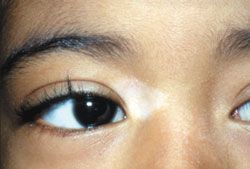Vitiligo
This white patch in the medial periorbital area of a 15-year-old girl had been present for several months. It was asymptomatic. The patient denied having had an injury to the area. Results of a potassium hydroxide preparation of a skin smear and fungus culture were negative. She had no history of other hypopigmented lesions and was otherwise healthy. There was no family history of vitiligo or autoimmune disease.

This white patch in the medial periorbital area of a 15-year-old girl had been present for several months. It was asymptomatic. The patient denied having had an injury to the area. Results of a potassium hydroxide preparation of a skin smear and fungus culture were negative.She had no history of other hypopigmented lesions and was otherwise healthy. There was no family history of vitiligo or autoimmune disease.
The patient was referred to a dermatologist who diagnosed vitiligo-which results from the complete absence of melanocytes in the epidermis.The hypopigmented lesions of vitiligo frequently appear on the head and neck and often in more than one area.1 The suspected cause of the depigmentation is an autoimmune event in persons with an underlying genetic predisposition. Affected children may have a family history of autoimmune disease or a family member with vitiligo.
The diagnosis can be upsetting to parents and children because of the unpredictable course and disfiguring appearance of vitiligo in some patients. Repigmentation may occur naturally or after treatment; however, pigment loss may occur all over the body and progress despite treatment.
Vitiligo is most commonly treated with topical corticosteroids. Use of high-potency corticosteroids has been effective in children.1 For patients with small areas of depigmentation, topical immunomodulators and photochemotherapy have also been effective.
This patient was treated with a topical corticosteroid and topical immunomodulator. After 2 to 4 weeks, the pigment returned.
References:
REFERENCE:
1.
Kwinter J, Pelletier J, Khambalia A, Pope E. High-potency steroid use in children with vitiligo: a retrospective study.
J Am Acad Deramtol.
2007;56:236-241.
Recognize & Refer: Hemangiomas in pediatrics
July 17th 2019Contemporary Pediatrics sits down exclusively with Sheila Fallon Friedlander, MD, a professor dermatology and pediatrics, to discuss the one key condition for which she believes community pediatricians should be especially aware-hemangiomas.